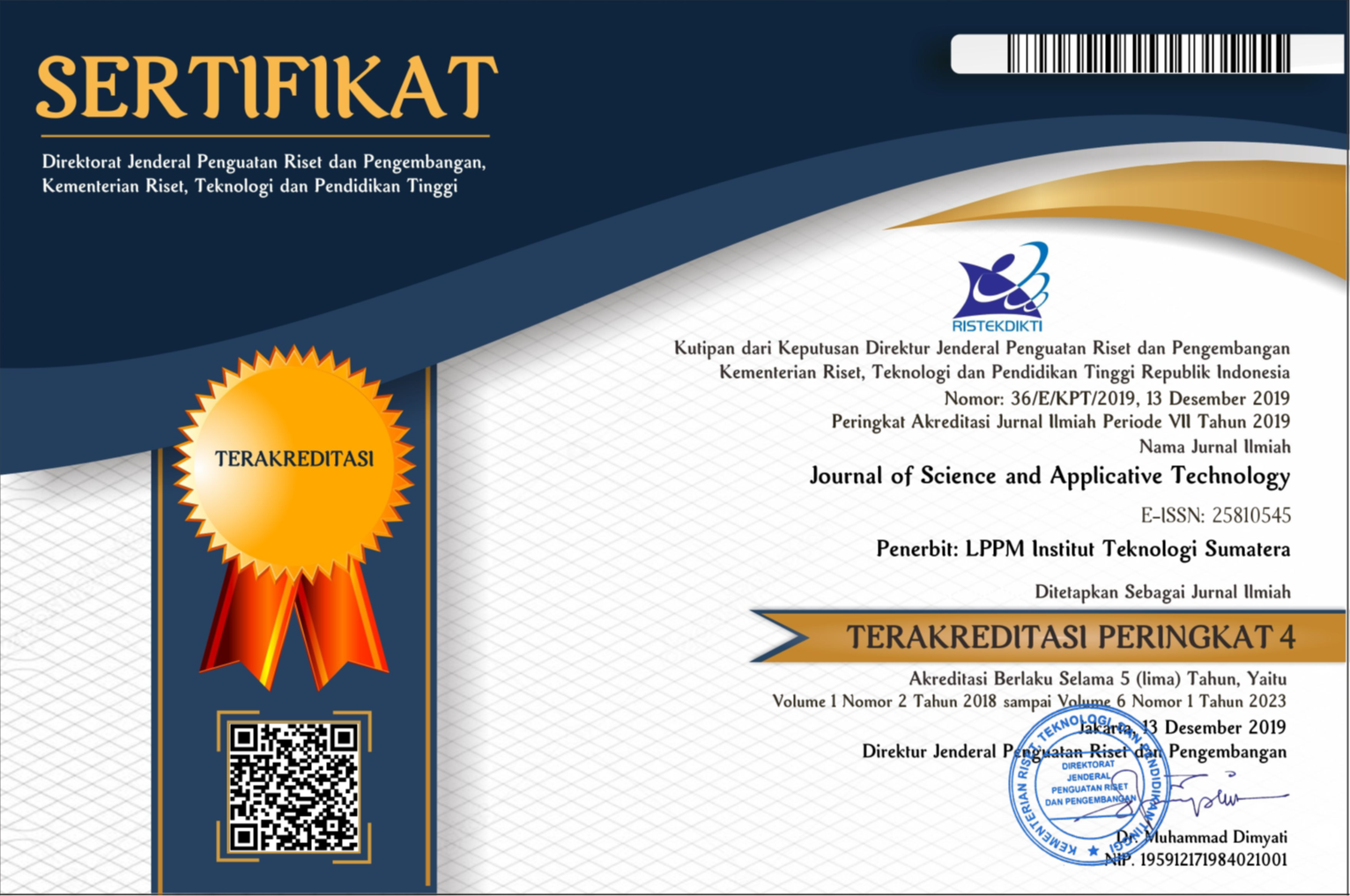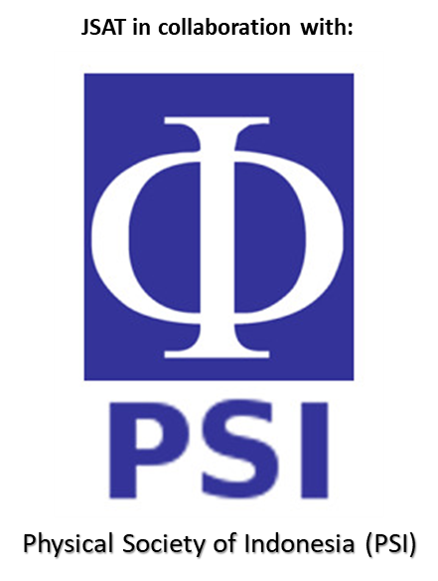Electrospun Nanofiber Poly (3,4-ethylenedioxytriophene): poly (styrene sulfonate) / poly (vinyl alcohol) as Strain Sensor Application
Abstract
A strain sensor based on poly (3,4-ethylenedioxytriophene): poly (styrene sulfonate)/poly (vinyl alcohol) (PEDOT: PSS/PVA) nanofiber has been successfully fabricated by electrospinning technique. Patterned copper wires were deposited on the mica flexible substrate with the distance of 1 mm. The sensor then characterized with various strain by one side bending. The conductivity of as-spun nanofiber mats can be adjusted from 0.03 to 1.2 µS cm-1 with various concentration of PVA and depends on its structure and its nanofiber diameter. The sensing mechanism of nanofiber-based strain sensor is due to the common piezoelectric effect of PEDOT:PSS polymer and unique nanostructure of nanofiber mats. When the sensor stretched, the length of nanofiber increase affecting the geometrical change and lead the increasing in resistance. This sensor shows good repeatability with gauge factor of 17. The performance of PEDOT:PSS/PVA nanofiber based strain sensor make nanofiber mats as promising alternative materials for strain sensor application.
Downloads
References
[2] H. Chen, M. Huang, Y. Liu, L. Meng, M. Ma, Functionalized electrospun nanofiber membranes for water treatment: A review, Sci. Total Environ. 739 (2020) 139944. doi:10.1016/j.scitotenv.2020.139944.
[3] F.E. Ahmed, B.S. Lalia, R. Hashaikeh, A review on electrospinning for membrane fabrication: Challenges and applications, Desalination. 356 (2015) 15–30. doi:10.1016/j.desal.2014.09.033.
[4] G. Panthi, M. Park, H.-Y. Kim, S.-J. Park, Electrospun polymeric nanofibers encapsulated with nanostructured materials and their applications: A review, J. Ind. Eng. Chem. 24 (2015) 1–13. doi:10.1016/j.jiec.2014.09.011.
[5] A. Refino, H.T. Yudistira, D.H.T. Nugroho, D.L. Puspitarum, Numerical Investigation of Electrospray Working Performance on Ethanol, J. Sci. Appl. Technol. 3 (2019) 51. doi:10.35472/jsat.v3i2.196.
[6] M. Yan lmaz, a. S. Sarac, A review: effect of conductive polymers on the conductivities of electrospun mats, Text. Res. J. 84 (2014) 1325–1342. doi:10.1177/0040517513495943.
[7] X. Wang, B.S. Hsiao, Electrospun nanofiber membranes, Curr. Opin. Chem. Eng. 12 (2016) 62–81. doi:10.1016/j.coche.2016.03.001.
[8] S.F. Chou, D. Carson, K.A. Woodrow, Current strategies for sustaining drug release from electrospun nanofibers, J. Control. Release. 220 (2015) 584–591. doi:10.1016/j.jconrel.2015.09.008.
[9] M. Cheng, Y. Qin, P. Qian, Z. Qin, Electrospun Cellulose Acetate Nanofibrous Mat as the Tissue Scaffold, in: Int. Conf. Adv. Energy, Environ. Chem. Eng., 2015: pp. 801–804.
[10] D. Serbezeanu, A.M. Popa, T. Stelzig, I. Sava, R.M. Rossi, G. Fortunato, Preparation and characterization of thermally stable polyimide membranes by electrospinning for protective clothing applications, Text. Res. J. 85 (2015) 1763–1775. doi:10.1177/0040517515576326.
[11] L. Persano, A. Camposeo, D. Pisignano, Active polymer nanofibers for photonics, electronics, energy generation and micromechanics, Prog. Polym. Sci. 43 (2014) 48–95. doi:10.1016/j.progpolymsci.2014.10.001.
[12] J. Yao, G. Li, C.W.M. Bastiaansen, T. Peijs, High performance co-polyimide nanofiber reinforced composites, Polym. (United Kingdom). 76 (2015) 46–51. doi:10.1016/j.polymer.2015.08.054.
[13] L. Nulhakim, M. Rozana, B. Yuliarto, H. Makino, Electrical and optical properties of Ga-doped ZnO thin films deposited by DC magnetron sputtering, J. Sci. Appl. Technol. 4 (2020) 15. doi:10.35472/jsat.v4i1.264.
[14] D.D. Yanti, E. Maryanti, Green Synthesis ZnO Nanoparticles Using Rinds Extract of Sapindus rarak DC, J. Sci. Appl. Technol. 5 (2021) 198–201. doi:10.35472/jsat.v5i1.372.
[15] T. Julian, S.N. Hidayat, A. Rianjanu, A.B. Dharmawan, H.S. Wasisto, K. Triyana, Intelligent Mobile Electronic Nose System Comprising a Hybrid Polymer-Functionalized Quartz Crystal Microbalance Sensor Array, ACS Omega. 5 (2020) 29492–29503. doi:10.1021/acsomega.0c04433.
[16] A. Rianjanu, E. Nurfani, M.F. Arif, K. Triyana, H.S. Wasisto, Stability evaluation of quartz crystal microbalances coated with polyvinyl acetate nanofibrous mats as butanol vapor sensors, Mater. Today Commun. 26 (2021) 101770. doi:10.1016/j.mtcomm.2020.101770.
[17] A. Rianjanu, T. Julian, S.N. Hidayat, N. Yulianto, N. Majid, I. Syamsu, H.S. Wasisto, K. Triyana, Quartz crystal microbalance humidity sensors integrated with hydrophilic polyethyleneimine-grafted polyacrylonitrile nanofibers, Sensors Actuators B Chem. 319 (2020) 128286. doi:10.1016/j.snb.2020.128286.
[18] H. Di Zhang, X. Yan, Z.H. Zhang, G.F. Yu, W.P. Han, J.C. Zhang, Y.Z. Long, Electrospun PEDOT:PSS/PVP Nanofibers for CO Gas Sensing with Quartz Crystal Microbalance Technique, Int. J. Polym. Sci. 2016 (2016) 1–6. doi:10.1155/2016/3021353.
[19] A. Rianjanu, R. Aflaha, N.I. Khamidy, M. Djamal, K. Triyana, H.S. Wasisto, Room-temperature ppb-level trimethylamine gas sensors functionalized with citric acid-doped polyvinyl acetate nanofibrous mats, Mater. Adv. 2 (2021) 3705–3714. doi:10.1039/D1MA00152C.
[20] R. Roto, A. Rianjanu, A. Rahmawati, I.A. Fatyadi, N. Yulianto, N. Majid, I. Syamsu, H.S. Wasisto, K. Triyana, Quartz Crystal Microbalances Functionalized with Citric Acid-Doped Polyvinyl Acetate Nanofibers for Ammonia Sensing, ACS Appl. Nano Mater. 3 (2020) 5687–5697. doi:10.1021/acsanm.0c00896.
[21] N. Liu, G. Fang, J. Wan, H. Zhou, H. Long, X. Zhao, Electrospun PEDOT:PSS–PVA nanofiber based ultrahigh-strain sensors with controllable electrical conductivity, J. Mater. Chem. 21 (2011) 18962. doi:10.1039/c1jm14491j.
[22] S. Zhang, H. Zhang, G. Yao, F. Liao, M. Gao, Z. Huang, K. Li, Y. Lin, Highly stretchable, sensitive, and flexible strain sensors based on silver nanoparticles/carbon nanotubes composites, J. Alloys Compd. 652 (2015) 48–54. doi:10.1016/j.jallcom.2015.08.187.
[23] E. Roh, B.U. Hwang, D. Kim, B.Y. Kim, N.E. Lee, Stretchable, Transparent, Ultrasensitive, and Patchable Strain Sensor for Human-Machine Interfaces Comprising a Nanohybrid of Carbon Nanotubes and Conductive Elastomers, ACS Nano. 9 (2015) 6252–6261. doi:10.1021/acsnano.5b01613.
[24] J. Seo, T.J. Lee, C. Lim, S. Lee, C. Rui, D. Ann, S.B. Lee, H. Lee, A Highly Sensitive and Reliable Strain Sensor Using a Hierarchical 3D and Ordered Network of Carbon Nanotubes, Small. 11 (2015) 2990–2994. doi:10.1002/smll.201401812.
[25] K.K. Kim, S. Hong, H.M. Cho, J. Lee, Y.D. Suh, J. Ham, S.H. Ko, Highly Sensitive and Stretchable Multidimensional Strain Sensor with Prestrained Anisotropic Metal Nanowire Percolation Networks, Nano Lett. 15 (2015) 5240–5247. doi:10.1021/acs.nanolett.5b01505.
[26] U. Lang, P. Rust, B. Schoberle, J. Dual, Piezoresistive properties of PEDOT:PSS, Microelectron. Eng. 86 (2009) 330–334. doi:10.1016/j.mee.2008.10.024.
[27] G. Latessa, F. Brunetti, A. Reale, G. Saggio, A. Di Carlo, Piezoresistive behaviour of flexible PEDOT:PSS based sensors, Sensors Actuators, B Chem. 139 (2009) 304–309. doi:10.1016/j.snb.2009.03.063.
[28] W.A. Daoud, J.H. Xin, Y.S. Szeto, Polyethylenedioxythiophene coatings for humidity, temperature and strain sensing polyamide fibers, Sensors Actuators, B Chem. 109 (2005) 329–333. doi:10.1016/j.snb.2004.12.067.
[29] J.C. Wang, R.S. ubhra Karmakar, Y.J. Lu, C.Y. Huang, K.C. Wei, Characterization of piezoresistive PEDOT:PSS pressure sensors with inter-digitated and cross-point electrode structures, Sensors (Basel). 15 (2015) 818–831. doi:10.3390/s150100818.
[30] T. Julian, A. Rianjanu, S.N. Hidayat, A. Kusumaatmaja, R. Roto, K. Triyana, Quartz crystal microbalance coated with PEDOT–PSS/PVA nanofiber for a high-performance humidity sensor, J. Sensors Sens. Syst. 8 (2019) 243–250. doi:10.5194/jsss-8-243-2019.
[31] S.N. Hidayat, T. Julian, A. Rianjanu, A. Kusumaatmadja, K. Triyana, Roto, Quartz crystal microbalance coated by PAN nanofibers and PEDOT:PSS for humidity sensor, in: 2017 Int. Semin. Sensors, Instrumentation, Meas. Metrol., IEEE, 2017: pp. 119–123. doi:10.1109/ISSIMM.2017.8124274.
[32] Chotimah, B. Winandianto, M. Munir, I. Kartini, A. Kusumaatmaja, K. Triyana, The electrical properties of PEDOT:PSS nanofibers, AIP Conf. Proc. 1755 (2016) 150013. doi:10.1063/1.4958586.
[33] D. Cho, N. Hoepker, M.W. Frey, Fabrication and characterization of conducting polyvinyl alcohol nanofibers, Mater. Lett. 68 (2012) 293–295. doi:10.1016/j.matlet.2011.10.109.
[34] - Chotimah, A. Rianjanu, B. Winardianto, M. Munir, I. Kartini, K. Triyana, Electrical Conductivity Improvement of Polyvinyl Alcohol Nanofiber by Solvent Vapour Treatment, Int. J. Adv. Sci. Eng. Inf. Technol. 6 (2016) 675. doi:10.18517/ijaseit.6.5.1055.
[35] N. Liu, G. Fang, W. Zeng, H. Long, L. Yuan, X. Zhao, 11 Novel ZnO Nanorod Flexible Strain Sensor and Strain Driving Transistor with an Ultrahigh 107 Scale “On” -“Off” Ratio Fabricated by a Single-Step Hydrothermal Reaction.pdf, (2011) 570–575.
[36] J.. Deitzel, J. Kleinmeyer, D. Harris, N.. Beck Tan, The effect of processing variables on the morphology of electrospun nanofibers and textiles, Polymer (Guildf). 42 (2001) 261–272. doi:10.1016/S0032-3861(00)00250-0.
[37] S. Ramakrishna, K. Fujihara, W.E. Teo, Z. Ma, T.C. Lim, An Introduction to Electrospinning and Nanofibers, World Scientific, Singapore, 2005.
[38] J.L. Duvail, P. Rétho, S. Garreau, G. Louarn, C. Godon, S. Demoustier-Champagne, Transport and vibrational properties of poly(3,4-ethylenedioxythiophene) nanofibers, Synth. Met. 131 (2002) 123–128. doi:10.1016/S0379-6779(02)00195-9.
Copyright (c) 2021 Journal of Science and Applicative Technology

This work is licensed under a Creative Commons Attribution-NonCommercial 4.0 International License.
All the content on Journal of Science and Applicative Technology (JSAT) may be used under the terms of the Creative Commons Attribution-NonCommercial 4.0 International License.
You are free to:
- Share - copy and redistribute the material in any medium or format
- Adapt - remix, transform, and build upon the material
Under the following terms:
- Attribution - You must give appropriate credit, provide a link to the license, and indicate if changes were made. You may do so in any reasonable manner, but not in any way that suggests the licensor endorses you or your use.
- NonCommercial - You may not use the material for commercial purposes.
- No additional restrictions - You may not apply legal terms or technological measures that legally restrict others from doing anything the license permits.





















